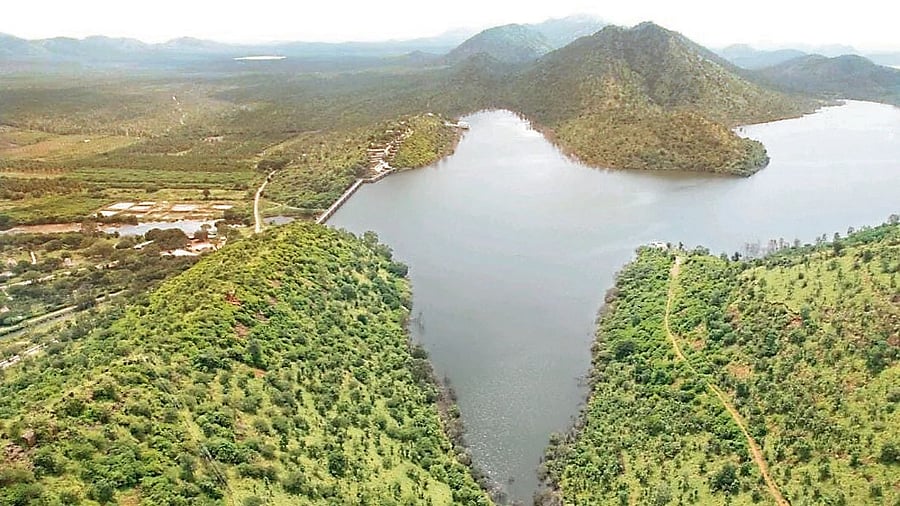
An aerial view of V V Sagara reservoir, resembling the map of India.
Credit: V Chandrappa
For decades, Karnataka’s oldest reservoir Vani Vilasa Sagara (V V Sagara), built across the Vedavathi river near Marikanive in Chitradurga district, was considered a lake. Some called it a valley, others a check dam and many simply dismissed it as a tank, its lack of crest gates contributing to its perceived modesty.
Built in 1907 by Nalwadi Krishnaraja Wadiyar as a tribute to his mother, Maharani Kempananjammanni Vani Vilasa Sannidhana, the reservoir remained largely unnoticed for years. This is because a few years after it was constructed, the river’s waters rarely reached it, defeating the vision of its royal patron.
The Vedavathi, originating as a small stream named Gauri in the Bababudangiri hills, gains volume from the confluence of the Veda and Avathi streams. For centuries, it remained seasonal, swelling during the monsoon only to dwindle by summer. The reservoir, nestled between the Marikanive hills near Hosadurga and Hiriyur, rarely received sufficient inflow and its presence faded from public memory beyond Chitradurga district.
That perception changed in 2022. Torrential rains in the Malnad region revived the Vedavathi. The river coursed through Ayyanakere, Madagada Kere and other smaller tanks on the way before surging into Vani Vilasa Sagara. The reservoir filled to the brim, only the second time since its construction and spilled over the overflow duct on its western ridge.
Unlike modern dams which generally have crest gates to release water, Vani Vilasa Sagara releases water only through the overflow duct once its 135 feet capacity is reached. After its first overflow in 1933, the event did not repeat for nearly nine decades, until the monsoon of 2022. Coincidentally, the second overflow occurred on September 2, the very date of its first spill. The force of the release inundated homes and plantations in downstream Hosadurga taluk.
For many, especially the younger generation, seeing the reservoir in full glory was exhilarating. Villagers who had waited a lifetime to see Marikanive brimming again were moved to tears. Aerial images, showing the reservoir shaped like the map of India, circulated widely on social media. Visitors from across the state and beyond flocked to the site, mesmerised by the cascading waters. At last, the long-overlooked reservoir captured public attention.
Farmer leader Echagatta Siddaveerappa recalls Nalwadi Krishnaraja Wadiyar’s vision to supply water to the drought-prone tracts of central Karnataka. “Nalwadi Krishnaraja Wadiyar personally inspected the Marikanive site in 1901. For almost nine decades the reservoir did not get filled as the Vedavathi’s upstream flow was barely sufficient even for the chain of tanks and coffee estates in Chikkamagaluru, Kadur and Birur,” he said.
The turnaround came after decades of struggle. In 2008, farmers staged a 543-day protest demanding implementation of the Upper Bhadra project. The severe drought of 2017, which wiped out millions of arecanut and coconut trees, intensified their struggle. Finally, pumping of Bhadra water into Vani Vilasa Sagara commenced in 2019. Generous monsoons combined with this intervention steadily raised water levels from 60 ft in 2019 to 102 ft the same year. It reached 106 ft in 2020, 125 ft in 2021 and a full-capacity overflow in 2022. The reservoir spilled again on January 12, 2024, owing to the release of Bhadra water and rain, and for the fourth time on October 19 this year following torrential rains.
Until recently, only devotees of Kanive Maramma shrine located near the reservoir visited this site. But with each overflow, the damsite has begun drawing visitors, even as infrastructure is struggling to keep pace. The area around the reservoir has no hotels or lodges, the garden behind the dam lies neglected, and parking and security are inadequate.
The other side
While Hiriyur taluk revels in the reservoir’s abundance, downstream villages in Hosadurga have begun facing floods. Farmers who cultivated on the dry riverbed and built houses when the Vedavathi was dry for decades now struggle against the surging waters. Officials note that compensation was paid during the original submergence a century ago. To regulate overflows once water levels exceed 130 feet, a plan to install crest gates at a cost of Rs 124 crore has been approved. Implementation is underway.